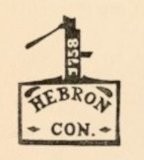
The Hebron Historical Society
Hebron, Connecticut
Enjoy Hebron - It's Here To Stay ™


Reuben Rowley artist Courtesy of Nathan Liverant and Son, Inc and Connecticut Historical Society, photography by Kevin Tulimieri
The traffic light marks the location of Hebron’s first and second meetinghouses (Congregational churches). In the colonial period, meetinghouses were considered the official religious and governmental heart of a town. Church and government were not separated in Connecticut until 1818. The location of the meetinghouse was a major article of contention during Hebron’s first fifty years since roads were built to connect meetinghouses and farmers needed road to sell their produce. In the 1740’s, Hebron’s meetinghouse was burned down as a protest to focus attention on the desire for satellite parishes to be established in Andover, Gilead and Marlborough.
To commemorate the end of the French and Indian War, merchant and farmer David Barber and his 6-year-old daughter Patience planted an elm tree next to the meetinghouse. It became the focal point of the center of Hebron. The Hebron Elm appears as the central focus of the painting by Reuben Rowley illustrated above. In 1904, the Hebron Elm was cut down.
Think about it
What might be a good symbol for Hebron today?
Where to go next
Walk west along the white picket fence.
Meet Your Neighbors QR Tours funded by the Hebron Greater Together Community Fund in conjunction with the Hebron Historical Society.
Please note that most of the structures you will see are privately owned. Please respect these properties by viewing them from the sidewalk.